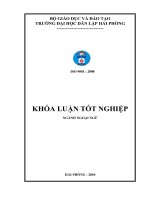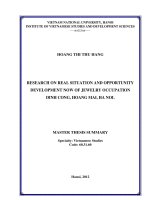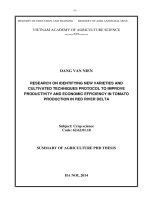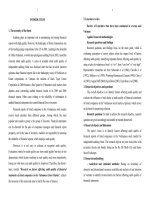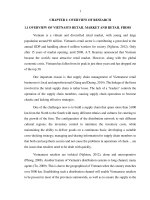Abstract of medical phd thesis: research on immunological changes and the efficacy of combined methotrexate and narrowband UVB phototherapy in the treatment of psoriasis vulgaris
Bạn đang xem bản rút gọn của tài liệu. Xem và tải ngay bản đầy đủ của tài liệu tại đây (453.28 KB, 29 trang )
MINISTRY OF EDUCATION AND TRAINING
MINISTRY OF DEFENCE
108 INSTITUTE OF CLINICAL MEDICAL AND PHARMACEUTICAL SCIENCES
-------------------------------------------------
PHAM DIEM THUY
RESEARCH ON IMMUNOLOGICAL
CHANGES AND THE EFFICACY OF
COMBINED METHOTREXATE AND
NARROWBAND UVB PHOTOTHERAPY IN
THE TREATMENT OF PSORIASIS VULGARIS
Speciality: Dermatology
Code: 62720152
ABSTRACT OF MEDICAL PhD THESIS
Hanoi – 2020
THE THESIS WAS CONDUCTED AT 108 INSTITUTE OF CLINICAL
MEDICAL AND PHARMACEUTICAL SCIENCES
Supervisors:
1. Ass. Prof. Dang Van Em, MD, PhD
2. Ass. Prof. Ly Tuan Khai, MD, PhD
Reviewers:
1.
2.
3.
This thesis will be defended to the Thesis Committee at 108 Institute
of Clinical Medical and Pharmaceutical Sciences
Day
Month
Year
The thesis can be found at:
1. National Library of Vietnam
2. Library of 108 Institute of Clinical Medical and
Pharmaceutical Sciences
3. Central Institute for Medical Science Infomation and
Technology
1
INTRODUCTION
Psoriasis is a chronic inflammatory disease that affects
men and women of all ages, regardless of ethnic origin, in all
countries. The pathogenesis of psoriasis is still not fully
understood.
Like other autoimmune diseases, psoriasis has been
shown to have a strong genetic component with external and
internal triggers, including stress, skin trauma, and infections.
The serum and tissue levels of cytokines were reported to be
elevated in psoriasis patients compared with normals, especially
Th1‑ and Th17‑associated cytokines.
The treatment strategy consists of induction and
maintenance phases with topical and systemic medications.
Methotrexate (MTX) remains the gold standard for the
treatment of moderate to severe psoriasis. NBUVB is indicated
to have quick treatment response, low rates of adverse effect,
long relapse-free period, and reduction in levels of the proinflammatory cytokines.
To our knowledge, no study has been conducted on
changes in cytokine profile during combination therapy of lowdose MTX and NBUVB in patients with psoriasis vulgaris.
Therefore,
we
conducted
the
study
“Research
on
immunological changes and the efficacy of combined
methotrexate and narrowband UVB phototherapy in the
treatment of psoriasis vulgaris” with the following objectives:
1. To describe demographic and clinical characteristics of
psoriasis patients at the Department of Dermatology,
2
Venerology, and Allergology of 108 Military Central
Hospital between August 2015 and May 2018.
2. To investigate immunological changes in peripheral blood
(CD4, CD8, IL-2, IL-4, IL-6, IL-8, IL-10, IL-17, TNF-α, and
INF-γ) of patients with moderate and severe psoriasis
vulgaris before and after the combined treatment of
methotrexate and narrowband UVB phototherapy
3. To evaluate the efficacy of combined methotrexate and
narrowband UVB phototherapy for moderate and severe
psoriasis
Chapter 1
OVERVIEW
1.1. Psoriasis vulgaris
1.1.1. Epidemiology
Incidence and prevalence: Psoriasis occurs in 2–3% of
the population worldwide. The prevalence of psoriasis was 1,5
% of the total population in Vietnam.
Sex ratio: Psoriasis prevalence is estimated to be equal in
males and females.
Age: While it can begin at any age, psoriasis has 2 peaks
of onset, the first at age 30 to 39 years and the second at age 60
years.
Clinical types of psoriasis: Plaque-type psoriasis,
occurring in 85%–90% of affected patients, is the most common
form of psoriasis, following by special types (10-15%),
3
including
localized
and
generalized
pustular
psoriasis,
erythrodermic psoriasis, and psoriatic arthritis.
1.1.2. Clinical features
The primary lesion is a symmetric, well-demarcated
erythematous plaque with a silvery scale. The prevalence of
pruritus and nail involvement in psoriasis is 20-30% and 3050% respectively. There are several clinical types of psoriasis
vulgaris, including plaque psoriasis, nummular psoriasis, guttate
psoriasis, and mixed type.
Type 1 begins on or before age 40 years; Type II begins
after the age of 40 years. Patients with early-onset, or type I
psoriasis, tended to have more relatives affected and more
severe disease than patients who have a later onset of disease or
type II psoriasis. In addition, strong associations have been
reported with human leukocyte antigen (HLA)-Cw6 in patients
with early onset, compared with later onset of psoriasis.
Psoriasis severity is defined using PASI score: mild
(PASI<10), moderate (PASI=10-20), severe (PASI >20).
Histopathology: Parakeratosis without hyperkeratosis,
acanthosis with a downward elongation of rete ridges, thin / no
granular
cell
layer,
suprapapillary
thinning,
Munro
microabscesses, prominent dermal capillaries, mixed dermal
infiltrate of lymphocytes, macrophages, and neutrophils.
1.1.3. Pathogenesis
There are three main factors:
- Genetic factors: Psoriasis is associated with certain
human leukocyte antigen (HLA) alleles, such as HLA-Cw6,
4
HLA-DR7. The psoriasis susceptibility loci include PSORS1:
6p21.3, PSORS2: 17q, PSORS3: 4q, PSORS4: 1q21, PSORS5:
3q21, PSORS6: 19p, PSORS7: 1p, PSORS8:16q, PSORS9:
4q31, PSORS10: 18p11, PSORS11: 5q31-q33, and PSORS12:
20q13. 4 - 91% of patients have a positive family history of
psoriasis.
- Immune disorders (role of cytokines, especially a key
role of the IL-17 / IL-23 axis).
- Environmental a factors a may a exacerbate a its
manifestations, or even trigger the disease, such as mental
stress, infection, trauma drugs, drinking, smoking, diet, climate,
and weather.
1.1.4. Treatment
- Goal of treatment: to achieve skin clearance and
maintain control of the lesions as well as improve patient’s
quality of life.
- Treatment strategy: induction and maintenance phase.
- Strategy for medication administration: single-agent,
combination, rotational, and sequential approaches.
- Therapeutics:
+Topical
medications:
keratolytics,
corticosteroids,
calcipotriol, etc.
+Phototherapy and photochemotherapy: PUVA, UVB,
and narrowband UVB (UVB 311 nm).
+Systemic
drugs:
Non-biological
drugs,
such
as
methotrexate, cyclosporine, acitretin; and biological drugs, such
5
as TNF-α inhibitors (infliximab, adalimumab), IL-17A inhibitor
(secukinumab).
1.2. Pathophysiological role of cytokines in psoriasis
Cytokines are small polypeptides (8-80 kD) produced in
response to antigens, microorganisms, or other non-infectious
stimuli. They are capable of regulating immune and
inflammatory reactions and interacting with the endocrine and
nervous systems.
Cytokines are produced by a broad range of cells,
including immune cells like macrophages, B lymphocytes, T
lymphocytes, and mast cells, as well as endothelial cells,
fibroblasts, and various stromal cells. There is a close
relationship between cytokine and adipokine. Adipokine’s
cytokine-mediated response is a complex process involving
many components and stages. This is a natural protective
response of the body. However, overproduction of cytokines,
adipokines will cause a variety of diseases, including psoriasis.
1.3. NBUVB phototherapy and methotrexate in the
treatment of psoriasis vulgaris
1.3.1. NBUVB phototherapy
Narrowband ultraviolet B (NBUVB) emitting light with a
peak around 311 nm. The exact mechanism of its therapeutic
action remains poorly understood. Several genetic and
molecular factors are induced by NBUVB, such as inhibition of
proliferation of keratinocytes, increased keratinocyte apoptosis,
and the effect on other skin cells like epidermal T lymphocytes,
melanocytes, and Langerhans cells. NBUVB can be safely used
6
in children and pregnancy. UVB can be combined with other
topical, systemic, or biologic agents to enhance efficacy.
1.3.2. Methotrexate in psoriasis
Methotrexate (MTX) was the first systemic agent used in
the treatment of psoriasis (1955) and remains the gold standard
for the treatment of moderate to severe psoriasis. The US FDA
approved the use of MTX for the treatment of psoriasis in 1972.
Methotrexate produces significant mitotic depression (S phase)
and has potent anti-inflammatory. The usual adult dose of
methotrexate is 7.5 to 25 mg weekly.
Chapter 2
SUBJECTS AND METHODS
2.1. Research subjects
- 260 inpatients were diagnosed with psoriasis at the
Department of Dermatology, Venerology, and Allergology of
108 Military Central Hospital between August 2015 and May
2018.
2.1.1. Diagnostic criteria
The diagnosis of psoriasis is primarily clinical: psoriasis
vulgaris
(plaque
psoriasis,
nummular
psoriasis,
guttate
psoriasis), special types (pustular psoriasis, erythrodermic
psoriasis, and psoriatic arthritis).
Histopathology: Parakeratosis without hyperkeratosis,
acanthosis with a downward elongation of rete ridges, thin / no
granular
cell
layer,
suprapapillary
thinning,
Munro
microabscesses, prominent dermal capillaries, mixed dermal
7
infiltrate of lymphocytes, macrophages, and neutrophils. Skin
biopsy is usually reserved for the evaluation of atypical cases.
2.1.2. Inclusion criteria
- Objective 1: All a patients a with definitive psoriasis
diagnosis.
- Objective 2:
+ Experimental group: 35 patients with moderate to
severe plaque psoriasis had no contraindication to methotrexate
and NBUVB phototherapy.
+ Control group: 35 volunteers, matched on age, gender,
had no autoimmune or infectious diseases.
- Objective 3: patients aged at least 16 years suffering
from
moderate-to-severe
plaque
psoriasis
and
had
no
contraindication to methotrexate and NBUVB phototherapy and
no history of systemic treatment at least 1 month prior to
enrollment.
2.1.3. Exclusion criteria
- Objective 1: Refused consent
- Objective 2:
+ Experimental group: Contraindicated to NBUVB and
methotrexate.
+ Control group: people who have autoimmune, liver,
infectious, or cancer diseases.
- Objective 3: Patients with other types of psoriasis.
Patients under 16 years of age or patients with contraindications
to methotrexate or NBUVB.
2.2. Research materials
8
Narrowband UVB unit manufactured by Daavlin of
Bryan, USA
Methotrexate 2.5 mg tablets
Bio-Rad 7-plex kit (IL-2, IL-4, IL-6, IL-8, IL-10, TNF-α,
and INF-γ) manufactured by Bio-Rad Laboratories, USA
Human IL-17 ELISA Kit manufactured by Sigma, USA
Other materials: Stiefel Physiogel 250ml
2.3. Research methods
2.3.1. Study design
Objective 1: Prospective cross-sectional study to describe
the demographic and clinical characteristics of psoriasis
patients.
Objective 2: Prospective cross-sectional study with a
control group to investigate immunological changes in
peripheral blood of patients after treatment.
Objective 3: Randomized prospective clinical trial to
evaluate the efficacy of combined methotrexate and narrowband
UVB phototherapy for psoriasis vulgaris.
2.3.2. Sample size
Objective 1: Convenience sampling. 260 inpatients.
Objective 2: The sample size is
calculated using the
WHO’s formula. Experimental group (35 patients) and control
group (35 volunteers).
Objective 3: Estimating the sample size for a clinical trial
with equal-sized groups. The experimental group (35 patients)
and control group (35 patients) were matched for age, sex, and
severity.
9
2.3.3. Protocols
2.3.3.1. To describe demographic and clinical characteristics of
psoriasis patients
History
taking,
physical
examination,
data
collection/gathering
2.3.3.2. To investigate immunological changes in peripheral
blood
- Experimental group:
+ Patients who satisfy the inclusion criteria will be
invited to participate in the study. 35 patients with moderate-tosevere plaque psoriasis.
+ First testing (before treatment): CD4, CD8, IL-2, IL-4,
IL-6, IL-8, IL-10, IL-17, TNF-α, IFN-γ, AST, ALT, urea,
creatinine, and CBC.
+ Inpatient treatment: NBUVB phototherapy
+
methotrexate 7.5 mg PO weekly for 4 weeks
+ Second testing (after treatment): CD4, CD8, IL-2, IL-4,
IL-6, IL-8, IL-10, IL-17, TNF-α, IFN-γ, AST, ALT, urea,
creatinine, and CBC.
- Control group: 35 volunteers, matched on age, gender
with the experimental group. Cytokine testing (IL-2, IL-4, IL-6,
IL-8, IL-10, IL-17, TNF-α, and IFN-γ).
2.3.3.3. To evaluate the efficacy of combined methotrexate and
narrowband UVB phototherapy
- 70 patients with moderate-to-severe plaque psoriasis
who satisfy the inclusion criteria were divided into 2 equal
groups matched for age, sex, and severity
10
- First testing (before treatment):
+ Experimental group: CD4, CD8, IL-2, IL-4, IL-6, IL-8,
IL-10, IL-17, TNF-α, IFN-γ, AST, ALT, urea, creatinine, and
CBC.
+ Control group: AST, ALT, urea, creatinine, and CBC.
- Inpatient treatment for 4 weeks.
- Second testing (after treatment): similar to the first
testing for 2 groups.
Patient treatment process:
- Experimental
group:
Methotrexate
+
NBUVB
phototherapy + Physiogel for 4 weeks
+ Methotrexate 7.5 mg PO weekly
+ NBUVB phototherapy: Patients were started at an
initial dose of 800 mJ/cm2 and increased by 100 mJ/cm² in
subsequent visits until reaching a dose of 2500 mJ/cm2 in the
last treatment. Treatment once daily, five days per week.
+ Physiogel once daily.
- Control group: Methotrexate + Physiogel for 4 weeks
Evaluating treatment effectiveness:
- Clinical outcome measures using PASI after 2 weeks, 3
weeks, and 4 weeks
- Side effects: Clinical findings (erythema and pruritus)
and laboratory test results (AST, ALT, urea, creatinine, and
CBC).
- Recurrence rate after 1, 2, and 3 months of the treatment
2.3.4. Laboratory techniques and procedures in research
2.3.4.1. Cytokine measurements
11
3 ml of blood were drawn from each patient. Tubes were
centrifuged at 4000xg for 30 minutes and divided into two equal
parts in Eppendorf tubes 1.5 mL. Serum samples were stored at
−80°C until analyzed.
Cytokine detection could be accomplished by sandwich
immunoassay on microspheres surface. This was carried out by
Bio-Plex System and Bio-Plex Manager Software. The test was
conducted at Military Medical University.
2.3.4.2. CD4 and CD8 T cell counting
2ml of venous blood samples collected in EDTAcontaining tubes should not be kept for more than 1 hour before
counting CD4 and CD8 T cells by flow cytometry method on
FACSCalibur system. The test was conducted at 108 Military
Central Hospital.
2.3.5. Outcome assessment
2.3.5.1. Severity of psoriasis
Psoriasis severity is defined using PASI score: mild
(PASI<10), moderate (PASI=10-20), severe (PASI >20).
2.3.5.2. Evaluating treatment effectiveness
- We calculated PASI score reduction, classifying it into
one of four groups: poor (< 25%), fair (25% or more to less
than 50%), moderate (50% or more to less than 75%), and good
(≥ 75%).
- Adverse effects:
+ Side effects
formation, etc.
of
NBUVB: itchy, redness, blister
12
+ Side effects of Methotrexate: Systemic side-effects
(headache, fever, chills, dizziness); skin (erythema, blisters,
urticaria, alopecia); abnormal laboratory test result (AST, ALT,
urea, creatinine, and CBC).
2.3.5.3. Recurrence rate
Relapse was defined as a loss of at least 25% of PASI
improvement over baseline.
Chapter 3
RESULTS
3.1. Demographic and clinical characteristics of psoriasis
patients
3.1.1. Demographic
Table 3.1. Distribution of patients with psoriasis by age
subgroups
Age
<29
30 - 39
40 – 49
50 – 59
60 – 69
≥ 70
Total
X ± SD
n
23
39
54
72
46
26
260
%
8,8
15,0
20,8
27,7
17,7
10,0
100
50,4±15,1 (18-89)
Conclusion: Highest prevalence of psoriasis was in the 50-59
age group, representing 27.7% of this group.
Table 3.4. Common psoriasis triggers (n = 260)
13
Trigger factors
Stress
Skin injuries
Infection (sinuses, nose, throat)
Drugs (antibiotics, pain killer)
Food
Frequency
115
27
17
22
79
%
44,2
10,4
6,5
8,5
30,4
Conclusion: The most common triggers cited in this study were
stress (44.2 %), followed by food (30.4 %) overall.
3.1.2. Clinical characteristics of psoriasis
Table 3.5. Clinical subtypes of psoriasis (n = 260)
Clinical subtypes
Psoriasis vulgaris
Psoriatic arthritis
Erythrodermic psoriasis
Pustular psoriasis
Total
n
218
17
16
9
260
%
83,9
6,5
6,1
3,5
100,00
Conclusion: Psoriasis vulgaris is the most common form of the
disease, accounting for 83.9% of all cases.
3.2. Immunological changes in peripheral blood of patients
with moderate to severe plaque psoriasis
3.2.1. The frequencies of CD4 and CD8 T cells in the
peripheral blood of the psoriatic patients
Table 3.7. Frequencies of CD4 and CD8 in the blood of patients
with psoriasis vulgaris (n = 35)
CD4 (cell/µl)
Before treatment
(X±SD)
After treatment
(X±SD)
682,3 ± 266,2
511,4 ± 196,7
p
(sign test)
<0,001
14
CD8 (cell/µl)
611,9 ± 365,6
<0,001
419,7 ± 191,0
Conclusion: After treatment, the frequencies of both CD4 and
CD8 decreased significantly (both p<0.001).
3.2.2. Cytokine serum levels in patients with psoriasis vulgaris
3.2.2.2. Cytokine serum levels before the treatment
Table 3.13. Cytokine serum levels in the study group and
control group before the treatment
Cytokine
IL-2 (pg/ml)
IL-4 (pg/ml)
IL-6 (pg/ml)
IL-8 (pg/ml)
IL-10 (pg/ml)
IL-17 (pg/ml)
TNF-α (pg/ml)
INF-γ (pg/ml)
Study group
(n=35)
(X±SD)
86,259 ± 70,50
8,041 ± 9,646
16,687 ± 79,244
53,024 ± 228,239
1,984 ± 2,113
1,798 ± 2,062
3,438 ± 11,090
8,311 ± 3,214
Control group
(n=35)
(X±SD)
5,000 ± 0,000
3,829 ± 5,541
3,084 ± 6,413
25,264 ± 66,821
1,000 ± 0,000
2,000 ± 0,000
1,715 ± 1,371
9,099 ± 2,894
p
<0,001
<0,01
>0,05
<0,05
<0,05
<0,001
>0,05
>0,05
Conclusion: Compared with the control group, psoriatic patients
had significantly different serum concentrations of several
cytokines (IL-2, IL-4, IL-8, IL-10).
Table 3.16. Cytokine serum levels in psoriatic patients of
different severity
Cytokine
IL-2 (pg/ml)
IL-4 (pg/ml)
Severe
(n=12)
X±SD
102,509 ± 66,116
14,022 ± 13,416
Moderate
(n=23)
X±SD
77,780 ± 72,645
4,920 ± 4,908
p
>0,05
<0,05
15
IL-6 (pg/ml)
IL-8 (pg/ml)
IL-10 (pg/ml)
IL-17 (pg/ml)
TNF-α (pg/ml)
INF-γ (pg/ml)
45,597 ± 134,231
130,570 ± 387,571
1,490 ± 1,230
2,699 ± 3,228
7,036 ± 18,934
8,977 ± 3,743
1,603 ± 1,432
12,565 ± 20,254
2,241 ± 2,437
1,327 ± 0,828
1,561 ± 0,274
7,963 ± 2,931
<0,01
>0,05
>0,05
>0,05
>0,05
>0,05
Conclusion: Serum concentration of IL-4, IL-6 in the severe
group was significantly higher than those in the moderate
group.
3.2.2.3. Serum cytokines levels after the treatment
Table 3.20. Cytokine serum levels in the study group and
control group after the treatment
Cytokine
Study group
(n=35)
Control group
(n=35)
p
IL-2 (pg/ml)
IL-4 (pg/ml)
IL-6 (pg/ml)
IL-8 (pg/ml)
IL-10 (pg/ml)
IL-17 (pg/ml)
TNF-α (pg/ml)
INF-γ (pg/ml)
97,332 ± 77,427
4,641 ± 6,592
11,843 ± 59,241
30,472 ± 56,832
1,897 ± 1,771
1,543 ± 0,779
2,496 ± 5,874
7,881 ± 2,934
5,000 ± 0,000
3,829 ± 5,541
3,084 ± 6,413
25,264 ± 66,821
1,000 ± 0,000
2,000 ± 0,000
1,715 ± 1,371
9,099 ± 2,894
<0,001
>0,05
>0,05
<0,05
<0,001
<0,01
>0,05
>0,05
Conclusion: Serum concentration of IL-2, IL-8, and IL-10 in the
study group was significantly higher than those in the control
group.
Table 3.21. Comparison of cytokine serum levels in the study
group before and after treatment (n = 35)
16
Cytokine
Before
After
p
IL-2 (pg/ml)
86,259 ± 70,50
97,332 ± 77,427
>0,05
IL-4 (pg/ml)
8,041 ± 9,646
4,641 ± 6,592
>0,05
IL-6 (pg/ml)
16,687 ± 79,244
11,843 ± 59,241
>0,05
IL-8 (pg/ml)
53,024 ± 228,239
30,472 ± 56,832
>0,05
IL-10 (pg/ml)
1,984 ± 2,113
1,897 ± 1,771
>0,05
IL-17 (pg/ml)
1,798 ± 2,062
1,543 ± 0,779
>0,05
TNF- α (pg/ml)
3,438 ± 11,090
2,496 ± 5,874
>0,05
INF-γ (pg/ml)
8,311 ± 3,214
7,881 ± 2,934
>0,05
Conclusion: There was no significant difference in cytokine
serum levels in the study group before and after treatment (all
p>0,05).
3.3. Efficacy of combined methotrexate and narrowband
UVB phototherapy for moderate and severe psoriasis
3.3.4. Comparison of treatment results between the two groups
3.3.4.1. Comparison of clinical effectiveness between the two
groups
Table 3.35. Comparison of PASI score before and after
n
Study group
Control group
p
35
35
treatment
Before
After
(X±SD)
(X±SD)
17.4 ± 5,2 5,4 ± 2,7
16,6 ± 4,6 7,3 ± 2,9
>0,05
<0,01
PASI reduction
(%)
69,0
56,0
<0,001
Conclusion: PASI reduction from baseline was significantly
higher in the study group than in the control group (p<0.001).
3.3.4.2. Comparison of adverse effects between the two groups
17
Table 3.36. Comparison of adverse effects between the two
groups
Study group
2 (5,7%)
1 (2,9%)
2 (5,7%)
2 (5,7%)
Nausea
Headache
Redness
Itching
Control group
3 (8,6%)
3 (8,6%)
0 (0%)
0 (0%)
p
>0,05
>0,05
>0,05
>0,05
Conclusion: There was no significant difference in adverse
effects between the two groups (p>0,05).
3.3.4.3. Comparison of recurrence rate between the two groups
Table 3.39. Comparison of recurrence rate between the two
groups after 3-month follow-up
Study group
Control group
Inactive psoriasis
23 (65,7%)
10 (28,6%)
Recurrence
12 (34,3%)
25 (71,4%)
p (χ2 test)
<0,01
Conclusion: The recurrence rate was significantly higher in the
control group than in the study group (p<0.01).
Chapter 4
DISCUSSION
4.1. Demographic and clinical characteristics of psoriasis
patients
4.1.1. Demographic
The highest percentage of psoriasis patients was observed
in the 50-59 age group (19.66% of the psoriasis population),
following by 40-49 age group (20.8%), 60-69 age group
(17.7%), 30-39 age group (15%), age above 70 (9,6%) and age
18
under 29 (8.8%). The mean age was 50.4 ± 15.1 (Table 3.1)
Similar results were found by Nguyen Lan Huong [118], [119].
Psychological stress played a role as a trigger factor in
44.2% of patients (Table 3.4). This correlates with published
studies of Dang Van Em [122], Nguyen Ba Hung [119].
Similarly, psychological factors can trigger flares of psoriasis in
31-88% and 10-62% of patients in Rousset et al and Zeng et al
study, respectively.
According to table 3.4 shown, skin trauma appeared as a
trigger factor in 10.4% of patients. These results are similar to
the results of studies of Nguyen Lan Huong (2014) and Nguyen
Ba Hung (2015) where skin trauma represented 9,24% and 11%
respectively. Psoriasis frequently flares up after upper
respiratory infections like tonsillitis, sinusitis, or strep throat in
6.5% of patients. An exacerbation of chronic psoriasis,
especially guttate psoriasis has been reported in association with
infections in many subsequent studies. Upper respiratory
infections, the most commonly streptococcal infection can
either exacerbate known psoriasis or trigger the onset of a
newly diagnosed psoriasis.
Table 3.4 also shows that drugs can trigger flares of
psoriasis in 8,1% of patients. Dang Van Em et al (1997)
reported about 30% of patients with chronic psoriasis had noted
worsening of their disease in association with drugs.
6.5% of patients (Table 3.4) reported an exacerbation of
psoriasis symptoms after ingesting a particular type of food or
drinks. The impact of diet on psoriasis has been examined by
19
authors. Management of diet may reduce the effect of
predisposing factors while simultaneously treating severe
comorbidities in psoriasis.
4.1.2. Clinical characteristics of psoriasis
Psoriasis was the predominant clinical type of psoriasis
(83.9%), followed by psoriatic arthritis (6.5%), erythrodermic
psoriasis (6.1%), and generalized pustular psoriasis (3.5%)
(Table 3.5).
The same findings were detected in the studies of Nguyen
Lan Huong et al (psoriasis vulgaris 85.87%), Nguyen Ba Hung
(psoriasis vulgaris 84,4%), and Phan Huy Thuc (84.52%).
4.2. Immunological changes in peripheral blood of patients
with moderate to severe plaque psoriasis
4.2.1. The frequencies of CD4 and CD8 T cells in the
peripheral blood of the psoriatic patients
The baseline mean frequencies of CD4 was 682.3±266.2
cells/µL and decreased to 511,4±196,7 cells/µL at the end of the
treatment. The baseline mean frequencies of CD8 was
611,9±365,6 cells/µL and decreased to 419,7±191,0 cells/µL at
the end of the treatment. After treatment, both frequencies of
CD4 and CD8 significantly decreased (both p<0.001). Dang
Van Em et al (1998) reported that frequencies of CD4, CD8,
and CD3 in 30 patients with psoriasis were statistically higher
than healthy controls (p<0,001). Carrascosa et al (2007) used
NBUVB to treat psoriasis. The frequencies of CD4, CD8 and
CD3 after treatment decreased 86%, 85%, 86,6% in dermis and
70%, 62%, 70,3% in hypodermis, respectively in their study.
20
Chiricozzi et al (2018) demonstrated that psoriasis individuals
exhibited higher CD4 and CD8 cell counts in both blood and
skin samples than healthy individuals. Different subsets of Th
cells have been reported to contribute to the pathogenesis of
psoriasis, such as Th1, Th9, Th17, and Th22 cells.
4.2.2. Cytokine serum levels in patients with psoriasis vulgaris
4.2.2.2. Cytokine serum levels before the treatment
According to table 3.13 shown, the serum levels of IL-2,
IL-4, IL-8, IL-10 in patients before treatment were significantly
higher than those measured in healthy blood donors (p<0.001,
p<0.01, p<0.05, p<0.05 respectively). Comparing to healthy
controls, the serum levels of IL-6, TNF-α, and IFN-γ in
psoriasis patients were not significantly different (all p>0,05).
Interestingly, the serum level of IL-17 in patients before
treatment was significantly lower than that measured in healthy
blood donors (p<0,001). Phan Huy Thuc et al (2015) showed
that the serum levels of IL-2, IL-4, IL-6, IL-8, IL-10, IL-17, IL23, TNF-α và IFN-γ in patients before treatment were
significantly higher than those measured in healthy blood
donors (all p<0.001). Anna Michalak-Stoma et al (2013)
examined the serum levels of IL-6, IL-12, IL-17, IL-20, IL-22,
and IL-23 in 60 psoriatic patients and 30 healthy controls. IL-6,
IL-20, and IL-22 concentrations were significantly higher in
psoriatic patients in comparison with the control group. The
positive correlations between the concentrations of IL-22 and
IL-20 and severity of psoriasis assessed with PASI and BSA
scores as well as IL-17 and PASI scores were found. Fan Bai et
21
al demonstrated that the pooled serum levels of TNF-α, IFN-γ,
IL-2, IL-6, IL-8, IL-18, IL-22, chemerin, lipocalin-2, resistin,
sE-selectin, fibrinogen, and C3 were higher in psoriasis patients
compared with healthy controls (all p<0.05). In contrast, serum
levels of IL-1β, IL-4, IL-10, IL-12, IL-17, IL-21, and IL-23
were not significantly different between psoriasis patients and
controls (all p>0.05). Tran Nguyen Anh Tu (2018) show that
the serum levels IL-17 và hsCRP in psoriasis patients were
statistically higher than those in healthy controls.
4.2.2.3. Serum cytokines levels after the treatment
Table 3.20 show that serum concentration of IL-2, IL-8,
and IL-10 was significantly higher in the study group (p<0.001,
p<0.05, and p<0.001 respectively). In contrast, IL-17 levels
were lower. Serum levels of IL-4, IL-6, TNF-α, INF-γ were not
significantly different between psoriasis patients and controls
(all p>0.05). Table 3.21 demonstrates that there was no
significant difference in cytokine serum levels in the study
group
before
overexpression
and
of
after
these
treatment
(all
proinflammatory
p>0,05).
cytokines
The
is
considered to be responsible for the maintenance and recurrence
of skin lesions.
Phan Huy Thuc et al (2015) showed that the serum level of
IL-17, TNF-α, IFN-γ significantly decreased in psoriasis
patients after treatment. Patients showed no significant change
in serum level of IL-2, IL-4, IL-6, IL-8, IL-10, and IL-23 after
treatment. Our results were inconsistent with Phan Huy Thuc.
This might be because of the shorter treatment duration and the
22
lower dose of methotrexate. In our study, the follow‐up sample
was taken after 4 weeks of treatment of low-dose methotrexate
(7.5 mg/week) and NBUVB while in the study of Phan Huy
Thuc, patients were treated with the higher dose of methotrexate
(15 mg/week) until achieving PASI 75. Mussi et al (1997)
compared the serum TNF-α levels of 37 patients and 30 healthy
controls. The median serum TNF-α levels of the patients were
significantly higher than those of controls After 4-week
treatments, both the PASI scores and the cytokine levels were
significantly and concomitantly reduced (p<0.001).
4.3. Efficacy of combined methotrexate and narrowband
UVB phototherapy for moderate and severe psoriasis
4.3.4. Comparison of treatment results between the two groups
4.3.4.1. Comparison of clinical effectiveness between the two
groups
In the study group, the treatment was effective in reducing
the PASI scores from 17,4±5,2 to 5,4±2,7 (69% reduction). In
the case of the control group, PASI scores were effectively
reduced from 16,6±4,6 to 7,3±2,9 (56% reduction). Results
showed that the reductions in the mean PASI in the study group
were significantly greater than in the control group (p<0.01).
In the study of Khadka (2015), 79 patients with chronic
plaque-type psoriasis were randomized to 2 groups. 39 patients
in group A (mean PASI 16,02±3,51) were treated with NBUVB
(3 times per week) and methotrexate (0.4 mg/kg/week,
maximum dose of 25 mg/week). 40 patients in group A (mean
PASI 14,44±2,8) were treated with methotrexate alone. There
23
was no statistically significant difference in the number of
patients who achieved PASI 75 between the two groups
(p>0.05). However, the mean total cumulative dose of
methotrexate received by the patients in group B (140,75±60,5
mg) was significantly higher than that in group A (56,5±12,5
mg). The percentages of patients achieving PASI 75 in the
study of Khadka (89% and 85%) are higher than that in our
study (69% and 57,5%) because they used a higher dose of
methotrexate (0.4 mg/kg/week) than we used (7.5 mg/week).
Furthermore, we demonstrated that clinical response rates were
higher in the study group compared with the control group
while there were no significant differences between 2 groups in
the study of Khadka et al. This might be because of different
environmental factors such as climate, humidity, occupation,
and different lifestyles and upon geographical location and
temporal distribution.
4.3.4.2. Comparison of adverse effects between the two groups
Side effect rates in both groups in the study of Khadka et al
were higher than that in our study. The reason could be that
they used a higher dose of methotrexate. The combined therapy
of methotrexate and NBUVB showed good clinical response
with a lower side effect rate and total cumulative dose of
methotrexate than methotrexate alone.
4.3.4.3. Comparison of recurrence rate between the two groups
Table 3.7 showed that the recurrence rate was significantly
higher in the control group than in the study group (p<0.01).
